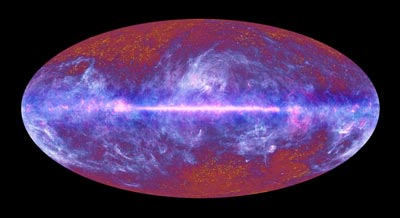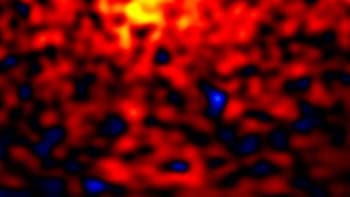
The latest results from the Planck space telescope have confirmed the presence of a microwave haze at the centre of the Milky Way. However, the haze appears to be more elongated than originally thought, which casts doubt over previous claims that annihilating dark matter is the cause of the emissions.
A roughly spherical haze of radiation at the heart of our galaxy was identified as far back as 2004 by the Wilkinson Microwave Anisotropy Probe (WMAP). Since then, some astrophysicists have suggested that this haze is produced by annihilating dark-matter particles.
However, some researchers have questioned whether the haze actually exists at all, suggesting that it could be an artefact of how the WMAP data were analysed. Doubts were raised as to whether WMAP was capable of picking out this weak signal buried deep in emissions from galactic dust, the cosmic microwave background (CMB) and other noise from hectic regions of the galaxy.
It is definitely there
The argument now seems to have been settled by the latest results from Planck, a European Space Agency mission launched in May 2009. “Crudely speaking, we agree with all the WMAP results,” explains Krzysztof Gorski of NASA’s Jet Propulsion Laboratory in California, who is a member of the Planck team. “Planck is more sensitive, and has a greater frequency range, taking us into a realm that WMAP couldn’t even see,” he told physicsworld.com. One of the telescope’s main objectives is to accurately map fluctuations in the CMB, so it is well suited to subtracting that radiation to reveal the haze.
With the presence of the haze independently verified, focus has returned to determining its origin. After its original discovery, some researchers, including Dan Hooper of Fermilab near Chicago, US, argued that annihilating dark matter could explain the galactic haze. Dark matter has long been thought to bind galaxies together, but detecting it directly has remained elusive. In Hooper’s mechanism, dark-matter particles annihilate to produce conventional electrons and positrons. These particles then spiral around the Milky Way’s magnetic field to produce the radiation we see as the microwave haze.
It still smells like dark matter to me
Dan Hooper, Fermilab
However, as well as confirming its existence, Planck was also able to reveal details of the shape of the haze. “The new results seem to suggest that the haze is elongated rather than spherical [as previously thought],” explains Hooper, who was not involved in the Planck research. “Simulations suggest that we would expect to find dark-matter halos that are roughly spherically symmetric,” he adds. There might still be room for a partial dark-matter explanation, however. “Our opinion is that no single current model explains the haze’s origin,” admits Gorski. So Hooper is not giving up. “It still smells like dark matter to me,” he says.
Related to Fermi bubbles?
The Planck observations also revealed a sharp southern edge to the haze. This implies that the formation mechanism is sporadic – if it were continuous, then the edges of the haze would appear diffuse. “The sharpness also implies that the haze might be related to the Fermi bubbles,” says Hooper. The Fermi bubbles are two giant, gamma-ray-emitting structures extending 25,000 light-years above and below the centre of the galaxy. Spotted by the Fermi space telescope in November 2010, these bubbles also have sharp, defined edges pointing towards a rapid release of energy as their cause, rather than a continuous, steady process.
It is possible, then, that the two phenomena have a common origin. “There may be some mechanism crossover between the haze and the bubbles,” says Andrew Pontzen, a theoretical cosmologist at the University of Oxford in the UK. “The next step would be to see exactly how much overlap there is in the data,” he adds. Any areas where the two phenomena do not overlap still leaves the door open for dark matter to play a part. “Maybe the cause [of the haze] is a mixture of dark-matter annihilation and other mechanisms,” Hooper adds.
Whichever explanation turns out to be correct, the Planck results have focused the argument. “Observationally, this is a great step forward,” Pontzen says. “However, the centre of the galaxy remains an intrinsically complicated place where a plethora of strange things are going on,” he adds. In the end, it might take Planck’s successors to settle the debate.
The Planck results are presented in a preprint on the arXiv server.



